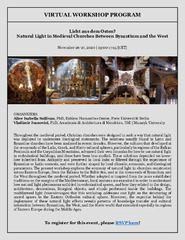| dc.creator | Yeager, Travis | |
| dc.creator | Danilovic, Dusan | |
| dc.creator | Karton, Charles | |
| dc.creator | Bogdanović, Jelena | |
| dc.creator | Dragović, Magdalena | |
| dc.date.accessioned | 2021-12-14T13:31:05Z | |
| dc.date.available | 2021-12-14T13:31:05Z | |
| dc.date.issued | 2020 | |
| dc.identifier.uri | https://grafar.grf.bg.ac.rs/handle/123456789/2493 | |
| dc.description.abstract | The local path of the Sun influences the architecture of our buildings. We have developed a model to measure the amount of sunlight that will pass through the windows of the Studenica Monastery Church. This model is general enough that it may be applied to any building for which the position and area of the windows are known. Our model allows for a quantitative measure of amount of Sun light that reaches any chosen set of windows of the Studenica Monastery Church. This model of many steps toward answering the question of whether or not the Studenica monastery in Serbia was constructed in a way that uses Greco-Roman astronomical knowledge of solar position. We employ the use of the solar position function developed by the National Renewable Energy Laboratory, Mahooti (2020). The solar calculator gives the position of the Sun with an accuracy of ±0.0003° for years -2000 to 6000 AD. We also use a spherical atmospheric model which accounts for building elevation to calculate solar intensity loss due to the atmosphere. Average values are chosen for Earth albedo, atmospheric temperature, pressure and refraction. The change in a building’s internal illumination due to rotation is dependent on the distribution of windows and the orientation of the building with respect to the cardinal directions. Our model of Studenica indicates that a skew of approximately 5° results in significant increases and reductions in total internal illumination by up to ±10 − 20% in both the morning and the evening. By isolating various groupings of windows we are also able to understand how the macroscopic illumination of various parts of the monastery are illuminated by the Sun. All groupings of windows see significant changes in illumination over the course of the year, except for the Dome windows, whose illumination remains the most stable over the course of a year. The most light seems to enter through the lowest windows with less entering in the upper cubic pedestal and Dome. Some of the increases in solar illumination seems to occur in periods of the morning that would have been of liturgical importance and decreases of sunlight seem to occur around noon and in the afternoon. Though, there is no hard and fast rule for when increases and decreases in illumination occur. There is a complex interplay between the Monastery’s architecture and the amount of sunlight, leaving us with further work to analyze the effects of light within Studenica by ray tracing. Our results are consistent with those found by Jabi and Potamianos (2007). This work builds upon previous work by Dragovic et al. (2019a,b) who have analyzed the regular geometric shapes of Raška churches that underlie their proportional construction. Highlighted is the importance of similar geometric proportions and the use of roots, the gold ratio and numeric ratios in both the Studenica and Žiča monastery complex. This approach is general enough to be applied to any ˇ structure for which the window areas and positions are known | sr |
| dc.language.iso | en | sr |
| dc.relation | Bridging the Divide Grant (2019-21) at Iowa State University | sr |
| dc.rights | openAccess | sr |
| dc.rights.uri | https://creativecommons.org/licenses/by-nc/4.0/ | |
| dc.source | Virtual Workshop: Natural Light in Medieval Churches Between Bizantium and West | sr |
| dc.subject | Architecture and illumination | sr |
| dc.subject | Numerical methods for sun illumination | sr |
| dc.subject | Applied science in architectural design | sr |
| dc.subject | Laser scanning and photogrammetry in architecture | sr |
| dc.subject | Studenica Monastery | sr |
| dc.subject | Medieval church architecture | sr |
| dc.title | Modeling the interior sunlight effects of Studenica Monastery | sr |
| dc.type | event | sr |
| dc.rights.license | BY-NC-ND | sr |
| dc.identifier.fulltext | http://grafar.grf.bg.ac.rs/bitstream/id/9695/bitstream_9695.pdf | |
| dc.identifier.rcub | https://hdl.handle.net/21.15107/rcub_grafar_2493 | |
| dc.type.version | publishedVersion | sr |

